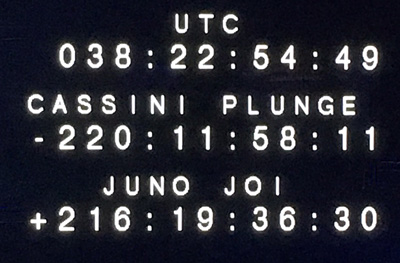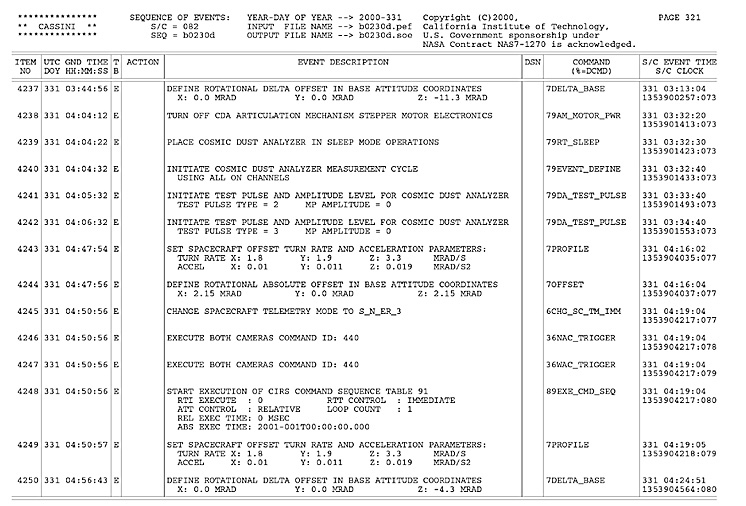Chapter 2: Reference Systems
Various expressions of time are commonly used in interplanetary space flight operations:
- UTC, Coordinated Universal Time, is the world-wide scientific standard of timekeeping. It is based upon carefully maintained atomic clocks and is highly stable. Its rate does not change by more than about 100 picoseconds per day. The addition or subtraction of leap seconds, as necessary, at two opportunities every year adjusts UTC for irregularities in Earth's rotation. UTC is used by astronomers, navigators, the Deep Space Network (DSN), and other scientific disciplines. Its reference point is Greenwich, England: when it is midnight there on Earth's prime meridian, it is midnight (00:00:00.000000) -- "all balls" -- UTC.
- UT, Universal Time also called Zulu (Z) time, was previously called Greenwich Mean Time, GMT. It is based on the imaginary "mean Sun," which averages out the effects on the length of the solar day caused by Earth's slightly non-circular orbit about the Sun. UT is not updated with leap seconds as is UTC. Its reference point is also Greenwich, England: when it is noon on the prime meridian, it is noon (12:00:00) UT. It is common to see outdated references to GMT, even in currently operating flight projects. It is also common to encounter references to UT or GMT when the system actually in use is UTC, for example, "Uplink the command at 1801Z."
- Local time is UT adjusted for location around the Earth in time zones. Its reference point is one's immediate locality: when it is 12:00:00 noon Pacific Time at JPL, it is 20:00:00 UTC, and 13:00:00 Mountain Time in Denver, Colorado. Many locations change between standard time and daylight saving time (see below). Local time is also determined on other planets when needed.
Local time on another planet is conceived as the equivalent value of time for the Sun's distance from the meridian, as it is on Earth. A planet that rotates more slowly than Earth would have an object in its sky at 1:00 local time move to 2:00 local time in more than an hour of Earth-clock time. Around 11:30 am or 12:30 pm at a particular location on Venus, the Sun would be nearly overhead. At 5:00 pm at a particular location on Mars, the Sun would be low in the west.


- TRM, Transmission time is the UTC time of uplink from Earth.
- OWLT, One-Way Light Time is the elapsed time it takes for light, or a radio signal, to reach a spacecraft or other body from Earth (or vice versa). Knowledge of OWLT is maintained to an accuracy of milliseconds. OWLT varies continuously as the spacecraft's distance from the Earth changes. Its reference points are the center of the Earth and the immediate position of a spacecraft or the center of a celestial body.
- SCET, Spacecraft Event Time is the UTC time onboard the spacecraft. It is equal to TRM + OWLT. ERT is equal to SCET + OWLT.
- SCLK, Spacecraft Clock is the value of a counter onboard a spacecraft, described further in Chapter 11. SCLK has a nearly-direct relationship with SCET: it is the best possible on-board estimate of SCET. SCLK is not as constant and stable as the UTC-derived SCET. Its units of measurement are different from SCET.
Tracking and predicting the exact relationship between SCLK and SCET is accomplished by analyzing telemetered SCLK values and trends with respect to the UTC-derived SCET, and regularly producing and applying a SCLK/SCET coefficients file which tracks the gradual drift of SCLK versus SCET.
- RTLT, Round-Trip Light Time is the elapsed time it takes for a signal to travel from Earth, be received and immediately transmitted or reflected by a spacecraft or other body, and return to the starting point. It is roughly equal to 2 x OWLT, but not exactly, because of the different amount of distance the signal must travel on each leg due to the constant motions of both Earth and spacecraft. For reference, RTLT from here to the Moon is around 3 seconds, to the Sun, about 17 minutes. Voyager 1's RTLT as of December 2012 is over 34 hours and increasing roughly an hour per year.
- ERT, Earth-Received Time is the UTC of an event received at a DSN station.
One more definition may be useful as background information:
- DT, Dynamical Time, has replaced Ephemeris Time, ET, as the independent argument in dynamical theories and ephemerides. Its unit of duration is based on the orbital motions of the Earth, Moon, and planets. DT has two expressions, Terrestrial Time, TT, (or Terrestrial Dynamical Time, TDT), and Barycentric Dynamical Time, TDB. More information on these, and still more timekeeping expressions, may be found at the U.S. Naval Observatory website. It is common to see outdated references to ET when a DT expression is intended, even in currently operating flight projects.
Daylight Saving Time begins for most of the United States at 2 a.m. local on the second Sunday in March (as of 2007). Standard time returns at 2 a.m. on the first Sunday in November (note that different time zones are switching at different moments). Hawaii, and Arizona (with the exception of the Navajo Nation) and the territories of Puerto Rico, Virgin Islands, Guam, and American Samoa do not observe DST but remain on Standard Time.
For the European Union, Summer Time, the equivalent of the U.S. Daylight Saving Time, begins at 0100 UTC on the last Sunday in March, and ends at 0100 UTC on the last Sunday in October (all time zones switch at the same moment in the EU).
The following image is an excerpt from a flight project's Sequence of Events (SOE). It illustrates use of UTC, ERT, TRM, OWLT, RTLT, SCET, and SCLK. (The SOE in general is discussed further in Chapter 15.)

The first vertical column in this SOE is a line item number. The next column specifies the item's UTC ground time, and the next column indicates whether that time is ERT or TRM. All on this page are ERT. Any items involving the DSN transmitter would appear as TRM. The COMMAND column specifies the command being executed on the spacecraft from the command sequence stored in the spacecraft's memory. The last column on the right shows the SCET, followed by the corresponding SCLK value, at which the command executes.




